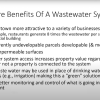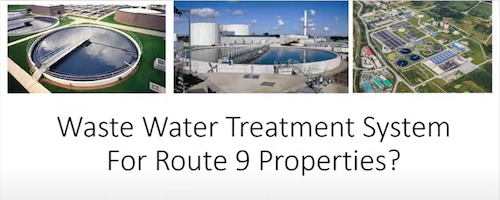Above: The Select Board is driving an effort to find a cost-effective way to provide wastewater treatment to increase commercial uses on Route 9. (image from presentation)
The Select Board was recently updated on a efforts to identify options for enabling commercial properties on Route 9 to have access to wastewater treatment.
Options include the possible Town investment in a facility that commercial properties that benefit would pay to connect to and use.
The goal is to make the properties more attractive to businesses and ultimately relieve the tax burden for residents. Based on the presentation, the Town would need to invest time and energy, but the expense to residents is unclear.
While a project could be expensive to build, one option is creating a private utility that the Town doesn’t fund building or running. Or it might be run by a multi-municipal partnership to ease the costs. Plus, the board hopes that a regional effort would help snag state grants.
A lot is still unknown at this stage. But the project could potentially tie in other property areas that aren’t on Route 9. And, if they can make progress quickly enough, the board might bring a project to Town Meeting as soon as this fall.
 The update presentation was made by member Al Hamilton on January 21st. Hamilton has been spearheading the initiative for the board with help from “a small group” including fellow Select Board member Sam Stivers.* He described his progress as first steps taken in a “Journey of a Thousand Miles”.
The update presentation was made by member Al Hamilton on January 21st. Hamilton has been spearheading the initiative for the board with help from “a small group” including fellow Select Board member Sam Stivers.* He described his progress as first steps taken in a “Journey of a Thousand Miles”.
Hamilton introduced the topic by focusing on the need to reverse a trend that has “slowly but steadily” shifted more of the tax burden “onto the residents, away from the commercial and Industrial properties”.
 Hamilton shared that the current ratio of total assessed taxable property values is 83.7% residential and only 16.3% Commercial-Retail-Industrial. He opined that will likely get worse. And he outlined what he saw as necessary changes to shift “back” to what he called the historic average ratio of 80%/20%.
Hamilton shared that the current ratio of total assessed taxable property values is 83.7% residential and only 16.3% Commercial-Retail-Industrial. He opined that will likely get worse. And he outlined what he saw as necessary changes to shift “back” to what he called the historic average ratio of 80%/20%.
 He forecast that would require $150M of CIP development in Southborough. And he pointed to the “Rt 9 corridor” as the only area that could handle that. While he identified multiple barriers to CIP Growth, the presentation focused on the importance of Wastewater Treatment for properties that “don’t perk or perk poorly”.
He forecast that would require $150M of CIP development in Southborough. And he pointed to the “Rt 9 corridor” as the only area that could handle that. While he identified multiple barriers to CIP Growth, the presentation focused on the importance of Wastewater Treatment for properties that “don’t perk or perk poorly”.
Hamilton explained that treatment is especially important for businesses that don’t typically work well with septic, including restaurants, grocery stores, Bio-Tech, and some kinds of manufacturing.
 He also highlighted tangential environmental benefits including reducing impermeable surfaces and ability to reuse treated water for irrigation and other “grey” uses.
He also highlighted tangential environmental benefits including reducing impermeable surfaces and ability to reuse treated water for irrigation and other “grey” uses.
 The Town has already had 3 wastewater studies completed over the past 1½ years to identify some design options, volumes needed, and possible disposal methods and sites.
The Town has already had 3 wastewater studies completed over the past 1½ years to identify some design options, volumes needed, and possible disposal methods and sites.
 And the “group” has reached out other towns and entities to ask questions and discuss possible collaborations. The goal is to make the properties more attractive to businesses and ultimately relieve the tax burden for residents. The most promising municipal options appeared to be partnering with Westborough Shrewsbury & Hopkinton or with Marlborough and Northborough.
And the “group” has reached out other towns and entities to ask questions and discuss possible collaborations. The goal is to make the properties more attractive to businesses and ultimately relieve the tax burden for residents. The most promising municipal options appeared to be partnering with Westborough Shrewsbury & Hopkinton or with Marlborough and Northborough.
 Based on advice from consultants and Mass Dept of Environmental Protection, Hamilton believed that a “ground discharge” system is the best (and cleanest) type of system for the Town to pursue. And he stressed that due to economies of scale, a bigger system would have better pay off. The systems can also be “designed to expand incrementally”.
Based on advice from consultants and Mass Dept of Environmental Protection, Hamilton believed that a “ground discharge” system is the best (and cleanest) type of system for the Town to pursue. And he stressed that due to economies of scale, a bigger system would have better pay off. The systems can also be “designed to expand incrementally”.
Hamilton indicated MassDEP was eager to help them navigate the process for a ground discharge system. And he learned through a DEP employee in a conversation earlier that day that they could focus on a “comprehensive plan” for just processing wastewater (rather than integrated plan with stormwater).
 According to Hamilton, many communities hire specialized, licensed companies to manage their treatment plant(s) as a private utility. The group met with a national operator, Veolia.
According to Hamilton, many communities hire specialized, licensed companies to manage their treatment plant(s) as a private utility. The group met with a national operator, Veolia.
Hamilton stressed the benefits of a private utility would mean that the Town doesn’t have to own or build the plant, or fund the plant or system. But the challenge is that it requires forming some kind of “utilities commission” to oversee rate setting.
 As of the meeting on the 21st, the group had one meeting with “Route 9 stakeholders”. The next day, Hamilton and Stivers met with the Board of Health and their Health Agents.
As of the meeting on the 21st, the group had one meeting with “Route 9 stakeholders”. The next day, Hamilton and Stivers met with the Board of Health and their Health Agents.
In that meeting, Stivers asked if there were other areas that are “notoriously difficult” and close enough to Route 9 that it might make sense to tie them into the system. He wondered if Fayville might be one. (He noted downtown would probably be too difficult given the distance.)
Health Agent Dennis Costello agreed with Fayville, which he said doesn’t have a lot of good soil, and thinking about what other areas might make sense. Hamilton followed that if they “connect to the schools” extending to downtown might be feasible.
 One of the big issues they’ll need to tackle is finding a place to locate a plant. That could require 5-10 acres. And they need to figure out whether to pursue a public or private partnership.
One of the big issues they’ll need to tackle is finding a place to locate a plant. That could require 5-10 acres. And they need to figure out whether to pursue a public or private partnership.
 In presentations, Hamilton laid out an ambitious goal of deciding on a plan to proceed with by late summer, then funding the start of work through a Fall Town Meeting.
In presentations, Hamilton laid out an ambitious goal of deciding on a plan to proceed with by late summer, then funding the start of work through a Fall Town Meeting.
 In the meantime, they’ll be doing more community outreach, including to other boards/committees, plus continue conversations with neighboring towns.
In the meantime, they’ll be doing more community outreach, including to other boards/committees, plus continue conversations with neighboring towns.
*According to Hamilton, Town Counsel confirmed that the “small group” doesn’t meet the threshold for a committee or subcommittee yet. (Which means it doesn’t need to follow Open Meeting Laws for agendas, minutes, quorums, etc.) But he followed that “we will be there shortly”



Al and Sam, thanks for your efforts on getting this started! It’s a very important project to relieve obstacles for economic development along Route 9.